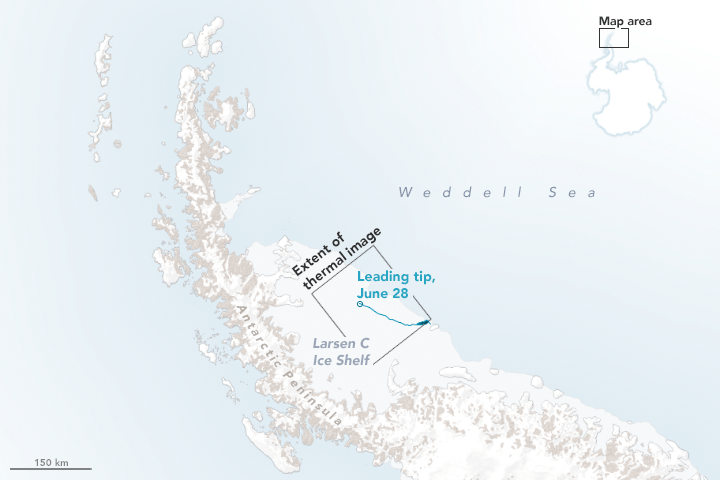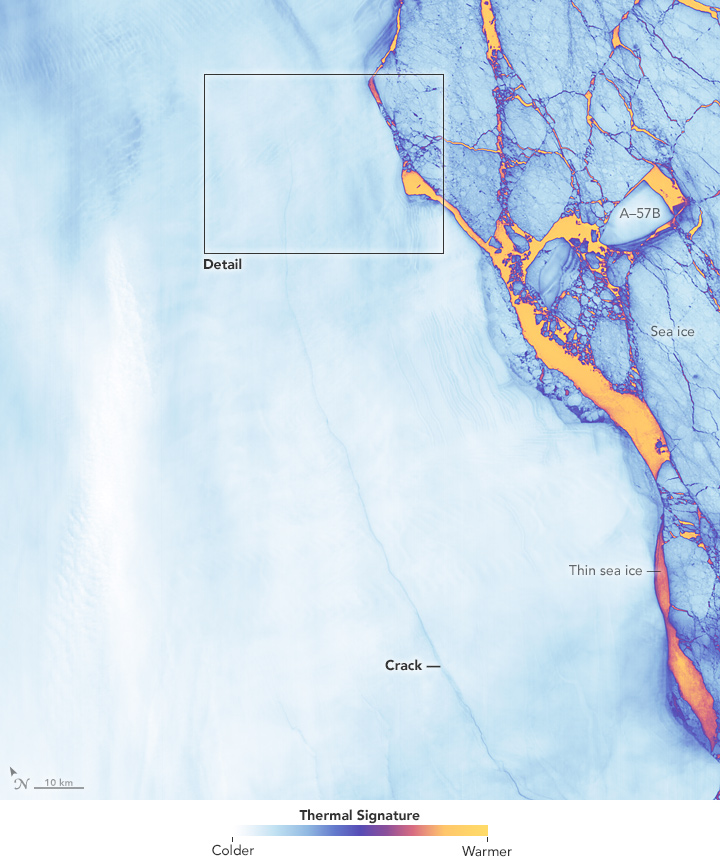Like that painful hangnail you’ve been eyeing for days — except billions of times larger, made of ice not keratin, and studied by dozens of scientists worldwide — a Delaware-sized glacier along Antarctica’s Larsen C ice shelf is hanging by a thread, poised to break off into the ocean any day now.
The Larsen C ice shelf as seen by the Synthetic Aperture Radar (SAR) instrument on the Sentinel-1A satellite on June 28th. Image: NASA Earth Observatory
It’s one of the largest iceberg calving events scientists have ever witnessed.
It’s been several years since a rift began creeping along the Larsen C ice shelf, located on the eastern rim of the Antarctic peninsula. The icy chasm, over 91.44m wide, grew in fits and starts, at first garnering little attention. Things started heating up last December, when the frosty abyss jumped 18km in a matter of weeks, followed by an another six mile growth spurt in January. At that point, it was clear Larsen C was gearing up to spit out a giant iceberg. Scientists at the UK-based Project MIDAS and NASA started paying close attention to every new set of satellite images.

Image: NASA Earth Observatory
The rift remained fairly stable in length for much of the spring, all the while slowly widening. Then, in May, it began to stir again. By the end of the month, the crack had added an additional 18km to its length, breaching a zone of “soft suture ice” and terminating eight miles from the sea.
Now, the soon-to-be iceberg is accelerating even more, signalling that “calving is imminent,” according to Project MIDAS. Yesterday, the team reported recent observations from the European Space Agency’s Sentinel-1 satellite showing that the growth of the Larsen C rift had tripled in speed between June 24th and June 28th. Its outer edge is now moving at “the highest speed ever recorded.”
“We don’t know when it’s going to go,” Christopher Shuman, a glaciologist at NASA who’s been watching the ice shelf closely in recent months, told Gizmodo. “But we are looking as frequently as possible at the available imagery to see the progression of the rift.”
Shuman explained that, because the Antarctic is shrouded in the blackness of polar night right now, “all the visible [satellite] channels are dark.” Instead, he’s using infrared data collected by the Landsat 8 satellite to study the progression of the crack, which appears brighter than the surrounding ice thanks to warm water seeping in from the ocean.

Image: NASA Earth Observatory
A crack of light at the bottom of the world, heralding the End Times. For the ice shelf, of course.
“It is an unusual event,” Shuman said. “It certainly isn’t a good sign for the Larsen C. If I lost that much of me,” roughly ten per cent of my surface area, “I’d be worried.”
That said, Shuman and others I’ve spoken with emphasise that glacier calving events, even very large ones like this, are a natural process along Antarctica’s frosty fringes, a bit like breaking off those overgrown fingernails. “Glaciologists are not alarmed about most of these processes; they are examples of Antarctica simply doing what we know Antarctica has done for thousands of years,” Helen Amanda Fricker, a professor at the Scripps Institution of Oceanography, wrote in The Guardian last week. Not only are calving events normal for icebergs, they don’t contribute directly to sea level rise, since they involve the breakup of ice already floating in — and displacing — water.
Some scientists are concerned that events like this could be bellwethers for the future, however. As Thomas Wagner, director of NASA’s polar science program, previously put it to Gizmodo, “What we’re worried about is what we’re seeing here is going to happen everywhere else,” referring specifically to West Antarctica’s Amundsen sea embayment, where ice shelves are melting and breaking apart more rapidly due to rising temperatures.
Others have voiced concern that the loss of this 1,930 square mile iceberg could cause inland ice from the Antarctic Peninsula to flow to sea faster, similarly to what happened after a giant iceberg broke off neighbouring Larsen B in the early 2000s, destabilizing the entire shelf. But so far, Shuman says, there’s little evidence that this calving event, which is occurring in the dead of winter, will trigger a cascading collapse similar to what happened at Larsen B in the height of the austral summer.
“At this time, we don’t see any sign that the rest of the Larsen C has a likelihood of further collapse,” he said. “And until that happens, there will be no additional contribution to global sea from Larsen C embayment glaciers. This event is significant for Larsen C, but it certainly isn’t analogous to Larsen B. At least not yet.”
As a final note, contrary to whatever Day After Tomorrow-esque mental image you have of a giant wall of ice crashing into the sea and triggering a 121.92m-high tsunami wave, Larsen C’s break up will continue to be slow and deliberate. At least, that’s how it will appear from our vantage point, with our hundreds-of-miles-high in the sky satellite eyes.
To a geologist, this is high drama.
“Just try to visualise the physics at work: the winds blowing from the top, the tides from below, the sea ice getting crunched,” Shuman said. “It’s just an amazing thing to wrap your head around.”
